Advance Healthcare and Data Environment: Chronic Diseases in Australia
VerifiedAdded on 2022/10/04
|6
|1320
|312
Report
AI Summary
This report delves into the critical issue of chronic diseases, particularly diabetes and obesity, within the Australian healthcare landscape. It highlights the alarming prevalence of these conditions, emphasizing their impact on public health and the strain they place on healthcare resources. The report provides an overview of diabetes and obesity, discussing their causes, risk factors, and the challenges associated with their management. It also examines the role of the healthcare data environment in addressing these diseases, including the importance of data-driven insights for prevention and treatment strategies. Furthermore, the report reviews existing literature and research, offering recommendations for public health practitioners and individuals alike, emphasizing the importance of personal responsibility and lifestyle choices in preventing and managing chronic diseases. The report concludes by advocating for intensified education and proactive measures to mitigate the impact of chronic diseases on the Australian population.
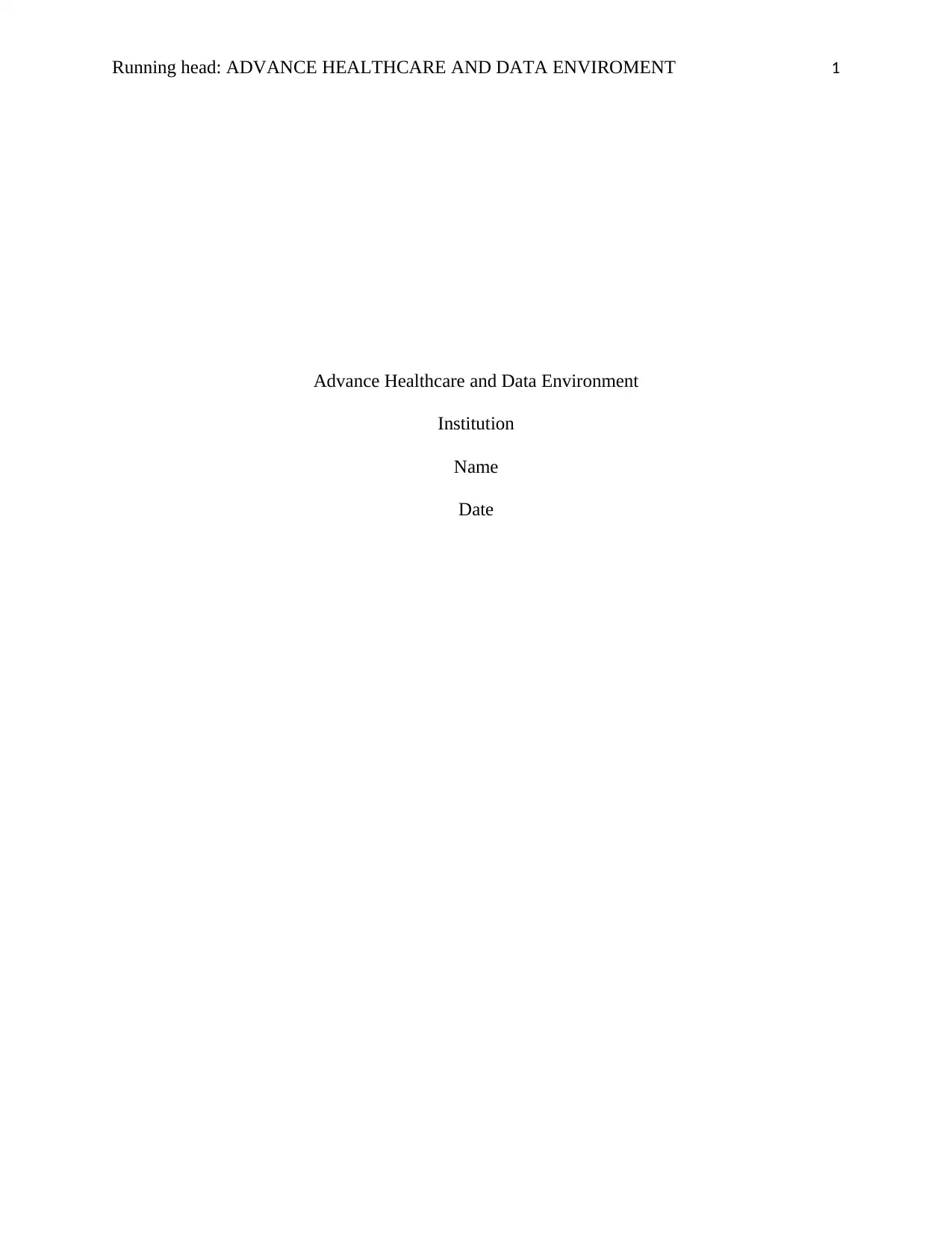
Running head: ADVANCE HEALTHCARE AND DATA ENVIROMENT 1
Advance Healthcare and Data Environment
Institution
Name
Date
Advance Healthcare and Data Environment
Institution
Name
Date
Paraphrase This Document
Need a fresh take? Get an instant paraphrase of this document with our AI Paraphraser
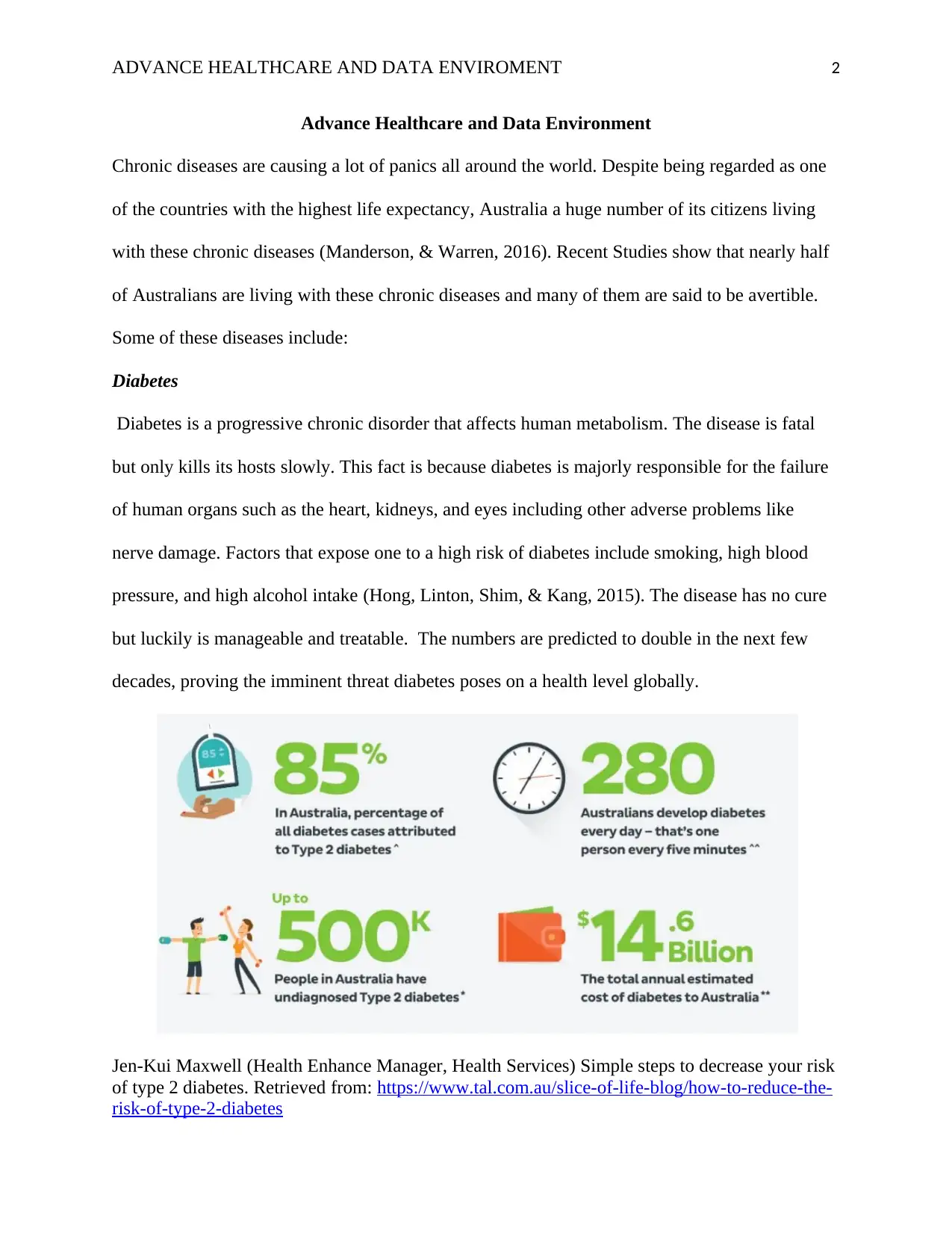
ADVANCE HEALTHCARE AND DATA ENVIROMENT 2
Advance Healthcare and Data Environment
Chronic diseases are causing a lot of panics all around the world. Despite being regarded as one
of the countries with the highest life expectancy, Australia a huge number of its citizens living
with these chronic diseases (Manderson, & Warren, 2016). Recent Studies show that nearly half
of Australians are living with these chronic diseases and many of them are said to be avertible.
Some of these diseases include:
Diabetes
Diabetes is a progressive chronic disorder that affects human metabolism. The disease is fatal
but only kills its hosts slowly. This fact is because diabetes is majorly responsible for the failure
of human organs such as the heart, kidneys, and eyes including other adverse problems like
nerve damage. Factors that expose one to a high risk of diabetes include smoking, high blood
pressure, and high alcohol intake (Hong, Linton, Shim, & Kang, 2015). The disease has no cure
but luckily is manageable and treatable. The numbers are predicted to double in the next few
decades, proving the imminent threat diabetes poses on a health level globally.
Jen-Kui Maxwell (Health Enhance Manager, Health Services) Simple steps to decrease your risk
of type 2 diabetes. Retrieved from: https://www.tal.com.au/slice-of-life-blog/how-to-reduce-the-
risk-of-type-2-diabetes
Advance Healthcare and Data Environment
Chronic diseases are causing a lot of panics all around the world. Despite being regarded as one
of the countries with the highest life expectancy, Australia a huge number of its citizens living
with these chronic diseases (Manderson, & Warren, 2016). Recent Studies show that nearly half
of Australians are living with these chronic diseases and many of them are said to be avertible.
Some of these diseases include:
Diabetes
Diabetes is a progressive chronic disorder that affects human metabolism. The disease is fatal
but only kills its hosts slowly. This fact is because diabetes is majorly responsible for the failure
of human organs such as the heart, kidneys, and eyes including other adverse problems like
nerve damage. Factors that expose one to a high risk of diabetes include smoking, high blood
pressure, and high alcohol intake (Hong, Linton, Shim, & Kang, 2015). The disease has no cure
but luckily is manageable and treatable. The numbers are predicted to double in the next few
decades, proving the imminent threat diabetes poses on a health level globally.
Jen-Kui Maxwell (Health Enhance Manager, Health Services) Simple steps to decrease your risk
of type 2 diabetes. Retrieved from: https://www.tal.com.au/slice-of-life-blog/how-to-reduce-the-
risk-of-type-2-diabetes
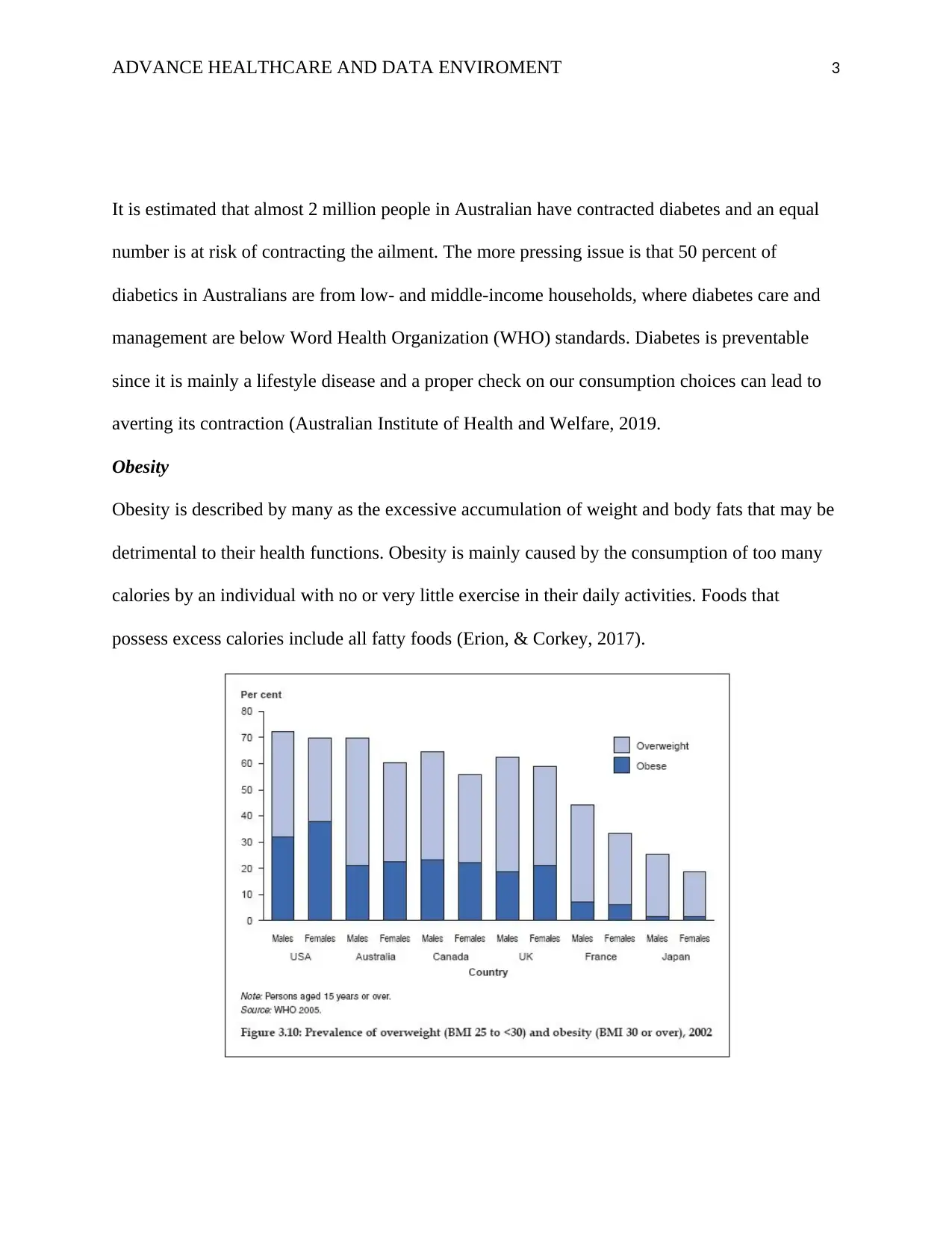
ADVANCE HEALTHCARE AND DATA ENVIROMENT 3
It is estimated that almost 2 million people in Australian have contracted diabetes and an equal
number is at risk of contracting the ailment. The more pressing issue is that 50 percent of
diabetics in Australians are from low- and middle-income households, where diabetes care and
management are below Word Health Organization (WHO) standards. Diabetes is preventable
since it is mainly a lifestyle disease and a proper check on our consumption choices can lead to
averting its contraction (Australian Institute of Health and Welfare, 2019.
Obesity
Obesity is described by many as the excessive accumulation of weight and body fats that may be
detrimental to their health functions. Obesity is mainly caused by the consumption of too many
calories by an individual with no or very little exercise in their daily activities. Foods that
possess excess calories include all fatty foods (Erion, & Corkey, 2017).
It is estimated that almost 2 million people in Australian have contracted diabetes and an equal
number is at risk of contracting the ailment. The more pressing issue is that 50 percent of
diabetics in Australians are from low- and middle-income households, where diabetes care and
management are below Word Health Organization (WHO) standards. Diabetes is preventable
since it is mainly a lifestyle disease and a proper check on our consumption choices can lead to
averting its contraction (Australian Institute of Health and Welfare, 2019.
Obesity
Obesity is described by many as the excessive accumulation of weight and body fats that may be
detrimental to their health functions. Obesity is mainly caused by the consumption of too many
calories by an individual with no or very little exercise in their daily activities. Foods that
possess excess calories include all fatty foods (Erion, & Corkey, 2017).
⊘ This is a preview!⊘
Do you want full access?
Subscribe today to unlock all pages.

Trusted by 1+ million students worldwide
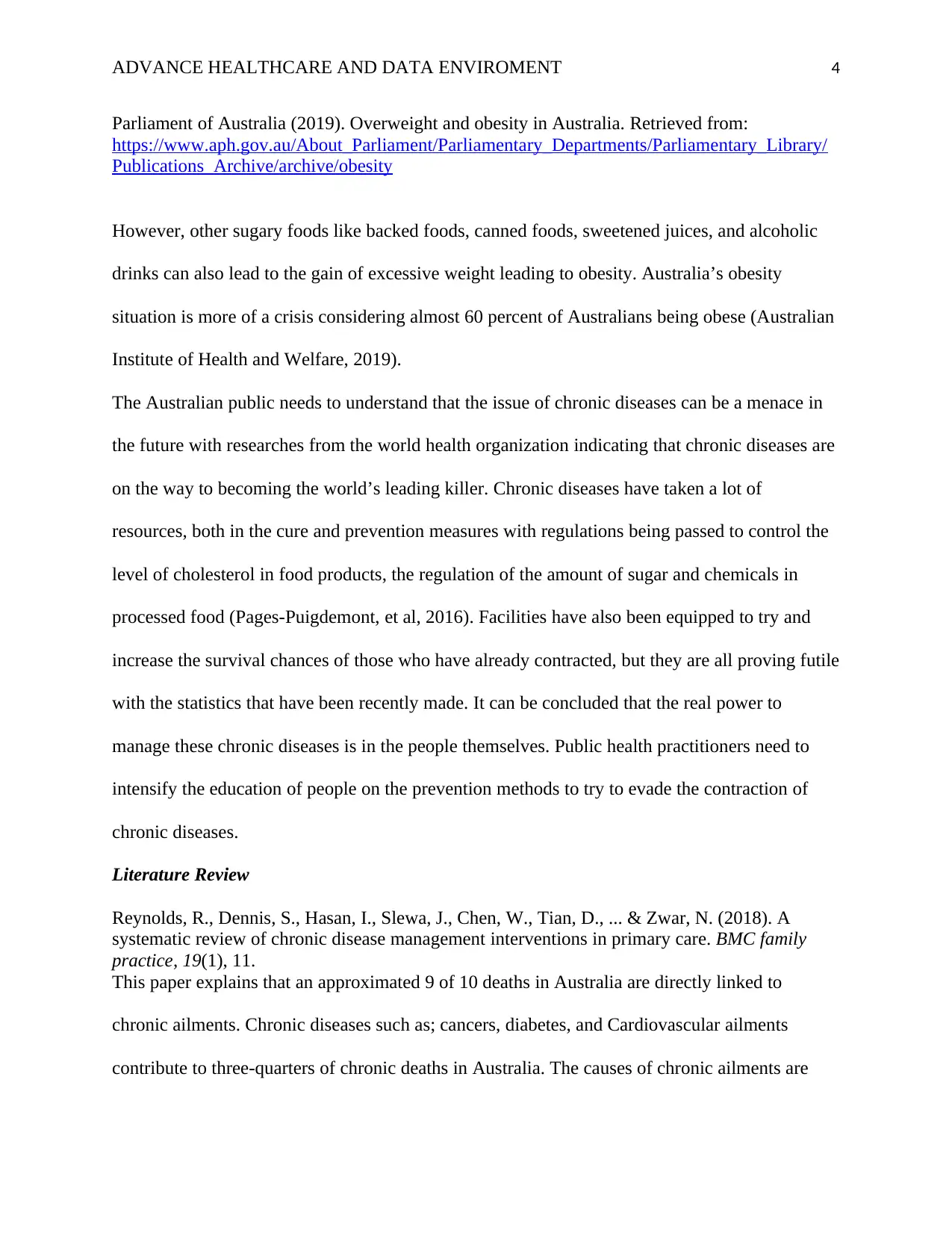
ADVANCE HEALTHCARE AND DATA ENVIROMENT 4
Parliament of Australia (2019). Overweight and obesity in Australia. Retrieved from:
https://www.aph.gov.au/About_Parliament/Parliamentary_Departments/Parliamentary_Library/
Publications_Archive/archive/obesity
However, other sugary foods like backed foods, canned foods, sweetened juices, and alcoholic
drinks can also lead to the gain of excessive weight leading to obesity. Australia’s obesity
situation is more of a crisis considering almost 60 percent of Australians being obese (Australian
Institute of Health and Welfare, 2019).
The Australian public needs to understand that the issue of chronic diseases can be a menace in
the future with researches from the world health organization indicating that chronic diseases are
on the way to becoming the world’s leading killer. Chronic diseases have taken a lot of
resources, both in the cure and prevention measures with regulations being passed to control the
level of cholesterol in food products, the regulation of the amount of sugar and chemicals in
processed food (Pages-Puigdemont, et al, 2016). Facilities have also been equipped to try and
increase the survival chances of those who have already contracted, but they are all proving futile
with the statistics that have been recently made. It can be concluded that the real power to
manage these chronic diseases is in the people themselves. Public health practitioners need to
intensify the education of people on the prevention methods to try to evade the contraction of
chronic diseases.
Literature Review
Reynolds, R., Dennis, S., Hasan, I., Slewa, J., Chen, W., Tian, D., ... & Zwar, N. (2018). A
systematic review of chronic disease management interventions in primary care. BMC family
practice, 19(1), 11.
This paper explains that an approximated 9 of 10 deaths in Australia are directly linked to
chronic ailments. Chronic diseases such as; cancers, diabetes, and Cardiovascular ailments
contribute to three-quarters of chronic deaths in Australia. The causes of chronic ailments are
Parliament of Australia (2019). Overweight and obesity in Australia. Retrieved from:
https://www.aph.gov.au/About_Parliament/Parliamentary_Departments/Parliamentary_Library/
Publications_Archive/archive/obesity
However, other sugary foods like backed foods, canned foods, sweetened juices, and alcoholic
drinks can also lead to the gain of excessive weight leading to obesity. Australia’s obesity
situation is more of a crisis considering almost 60 percent of Australians being obese (Australian
Institute of Health and Welfare, 2019).
The Australian public needs to understand that the issue of chronic diseases can be a menace in
the future with researches from the world health organization indicating that chronic diseases are
on the way to becoming the world’s leading killer. Chronic diseases have taken a lot of
resources, both in the cure and prevention measures with regulations being passed to control the
level of cholesterol in food products, the regulation of the amount of sugar and chemicals in
processed food (Pages-Puigdemont, et al, 2016). Facilities have also been equipped to try and
increase the survival chances of those who have already contracted, but they are all proving futile
with the statistics that have been recently made. It can be concluded that the real power to
manage these chronic diseases is in the people themselves. Public health practitioners need to
intensify the education of people on the prevention methods to try to evade the contraction of
chronic diseases.
Literature Review
Reynolds, R., Dennis, S., Hasan, I., Slewa, J., Chen, W., Tian, D., ... & Zwar, N. (2018). A
systematic review of chronic disease management interventions in primary care. BMC family
practice, 19(1), 11.
This paper explains that an approximated 9 of 10 deaths in Australia are directly linked to
chronic ailments. Chronic diseases such as; cancers, diabetes, and Cardiovascular ailments
contribute to three-quarters of chronic deaths in Australia. The causes of chronic ailments are
Paraphrase This Document
Need a fresh take? Get an instant paraphrase of this document with our AI Paraphraser
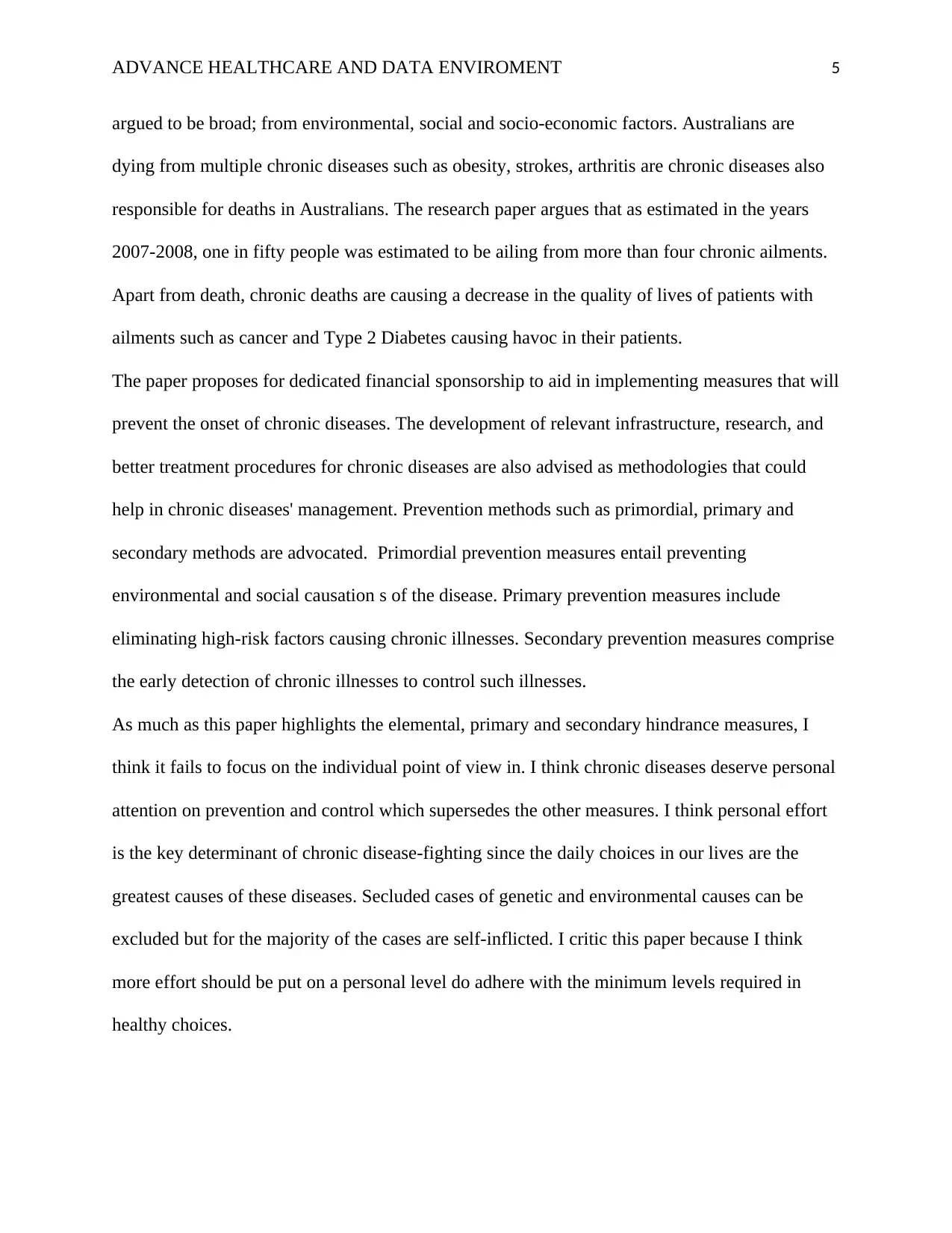
ADVANCE HEALTHCARE AND DATA ENVIROMENT 5
argued to be broad; from environmental, social and socio-economic factors. Australians are
dying from multiple chronic diseases such as obesity, strokes, arthritis are chronic diseases also
responsible for deaths in Australians. The research paper argues that as estimated in the years
2007-2008, one in fifty people was estimated to be ailing from more than four chronic ailments.
Apart from death, chronic deaths are causing a decrease in the quality of lives of patients with
ailments such as cancer and Type 2 Diabetes causing havoc in their patients.
The paper proposes for dedicated financial sponsorship to aid in implementing measures that will
prevent the onset of chronic diseases. The development of relevant infrastructure, research, and
better treatment procedures for chronic diseases are also advised as methodologies that could
help in chronic diseases' management. Prevention methods such as primordial, primary and
secondary methods are advocated. Primordial prevention measures entail preventing
environmental and social causation s of the disease. Primary prevention measures include
eliminating high-risk factors causing chronic illnesses. Secondary prevention measures comprise
the early detection of chronic illnesses to control such illnesses.
As much as this paper highlights the elemental, primary and secondary hindrance measures, I
think it fails to focus on the individual point of view in. I think chronic diseases deserve personal
attention on prevention and control which supersedes the other measures. I think personal effort
is the key determinant of chronic disease-fighting since the daily choices in our lives are the
greatest causes of these diseases. Secluded cases of genetic and environmental causes can be
excluded but for the majority of the cases are self-inflicted. I critic this paper because I think
more effort should be put on a personal level do adhere with the minimum levels required in
healthy choices.
argued to be broad; from environmental, social and socio-economic factors. Australians are
dying from multiple chronic diseases such as obesity, strokes, arthritis are chronic diseases also
responsible for deaths in Australians. The research paper argues that as estimated in the years
2007-2008, one in fifty people was estimated to be ailing from more than four chronic ailments.
Apart from death, chronic deaths are causing a decrease in the quality of lives of patients with
ailments such as cancer and Type 2 Diabetes causing havoc in their patients.
The paper proposes for dedicated financial sponsorship to aid in implementing measures that will
prevent the onset of chronic diseases. The development of relevant infrastructure, research, and
better treatment procedures for chronic diseases are also advised as methodologies that could
help in chronic diseases' management. Prevention methods such as primordial, primary and
secondary methods are advocated. Primordial prevention measures entail preventing
environmental and social causation s of the disease. Primary prevention measures include
eliminating high-risk factors causing chronic illnesses. Secondary prevention measures comprise
the early detection of chronic illnesses to control such illnesses.
As much as this paper highlights the elemental, primary and secondary hindrance measures, I
think it fails to focus on the individual point of view in. I think chronic diseases deserve personal
attention on prevention and control which supersedes the other measures. I think personal effort
is the key determinant of chronic disease-fighting since the daily choices in our lives are the
greatest causes of these diseases. Secluded cases of genetic and environmental causes can be
excluded but for the majority of the cases are self-inflicted. I critic this paper because I think
more effort should be put on a personal level do adhere with the minimum levels required in
healthy choices.
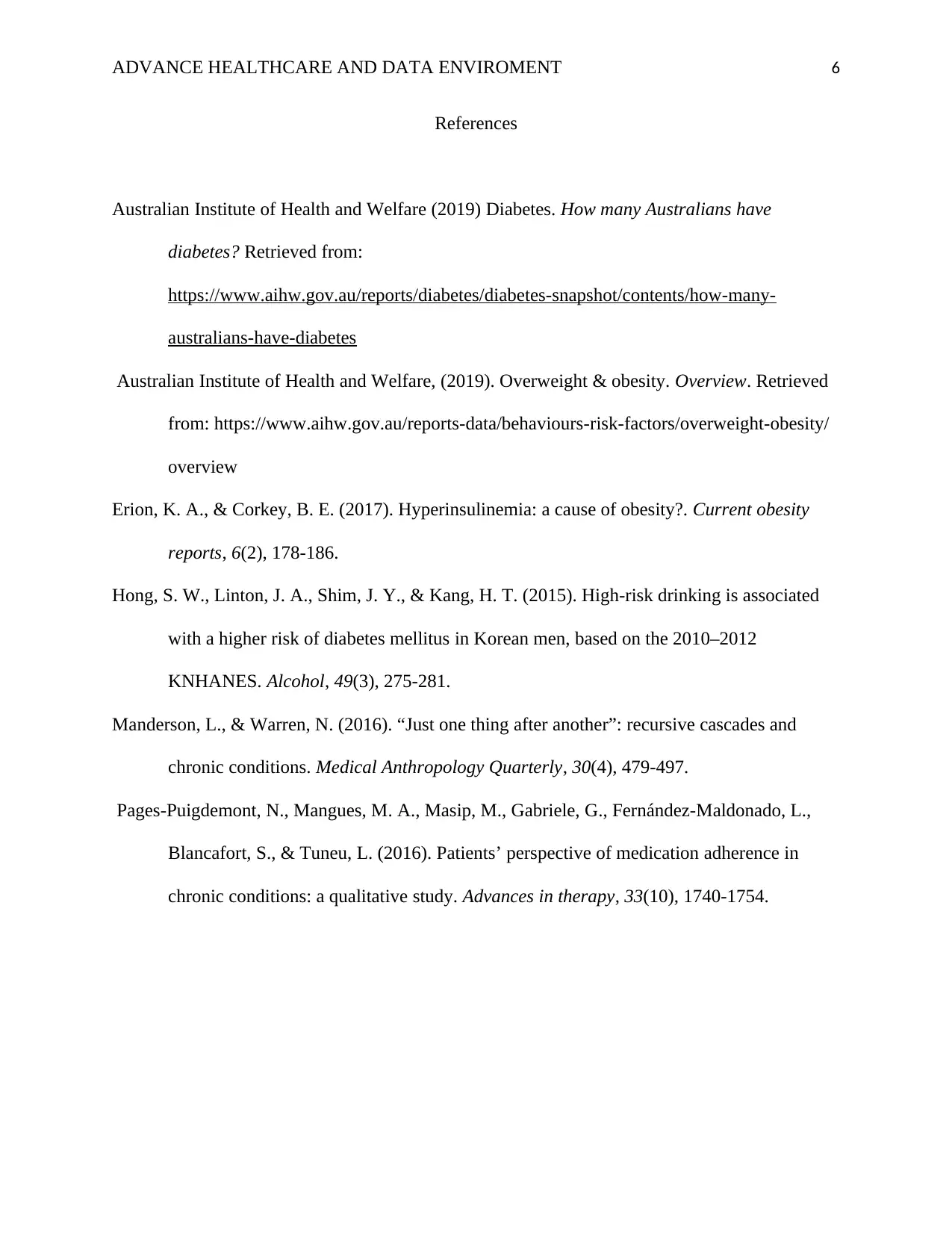
ADVANCE HEALTHCARE AND DATA ENVIROMENT 6
References
Australian Institute of Health and Welfare (2019) Diabetes. How many Australians have
diabetes? Retrieved from:
https://www.aihw.gov.au/reports/diabetes/diabetes-snapshot/contents/how-many-
australians-have-diabetes
Australian Institute of Health and Welfare, (2019). Overweight & obesity. Overview. Retrieved
from: https://www.aihw.gov.au/reports-data/behaviours-risk-factors/overweight-obesity/
overview
Erion, K. A., & Corkey, B. E. (2017). Hyperinsulinemia: a cause of obesity?. Current obesity
reports, 6(2), 178-186.
Hong, S. W., Linton, J. A., Shim, J. Y., & Kang, H. T. (2015). High-risk drinking is associated
with a higher risk of diabetes mellitus in Korean men, based on the 2010–2012
KNHANES. Alcohol, 49(3), 275-281.
Manderson, L., & Warren, N. (2016). “Just one thing after another”: recursive cascades and
chronic conditions. Medical Anthropology Quarterly, 30(4), 479-497.
Pages-Puigdemont, N., Mangues, M. A., Masip, M., Gabriele, G., Fernández-Maldonado, L.,
Blancafort, S., & Tuneu, L. (2016). Patients’ perspective of medication adherence in
chronic conditions: a qualitative study. Advances in therapy, 33(10), 1740-1754.
References
Australian Institute of Health and Welfare (2019) Diabetes. How many Australians have
diabetes? Retrieved from:
https://www.aihw.gov.au/reports/diabetes/diabetes-snapshot/contents/how-many-
australians-have-diabetes
Australian Institute of Health and Welfare, (2019). Overweight & obesity. Overview. Retrieved
from: https://www.aihw.gov.au/reports-data/behaviours-risk-factors/overweight-obesity/
overview
Erion, K. A., & Corkey, B. E. (2017). Hyperinsulinemia: a cause of obesity?. Current obesity
reports, 6(2), 178-186.
Hong, S. W., Linton, J. A., Shim, J. Y., & Kang, H. T. (2015). High-risk drinking is associated
with a higher risk of diabetes mellitus in Korean men, based on the 2010–2012
KNHANES. Alcohol, 49(3), 275-281.
Manderson, L., & Warren, N. (2016). “Just one thing after another”: recursive cascades and
chronic conditions. Medical Anthropology Quarterly, 30(4), 479-497.
Pages-Puigdemont, N., Mangues, M. A., Masip, M., Gabriele, G., Fernández-Maldonado, L.,
Blancafort, S., & Tuneu, L. (2016). Patients’ perspective of medication adherence in
chronic conditions: a qualitative study. Advances in therapy, 33(10), 1740-1754.
⊘ This is a preview!⊘
Do you want full access?
Subscribe today to unlock all pages.

Trusted by 1+ million students worldwide
1 out of 6
Related Documents
Your All-in-One AI-Powered Toolkit for Academic Success.
+13062052269
info@desklib.com
Available 24*7 on WhatsApp / Email
![[object Object]](/_next/static/media/star-bottom.7253800d.svg)
Unlock your academic potential
Copyright © 2020–2025 A2Z Services. All Rights Reserved. Developed and managed by ZUCOL.





